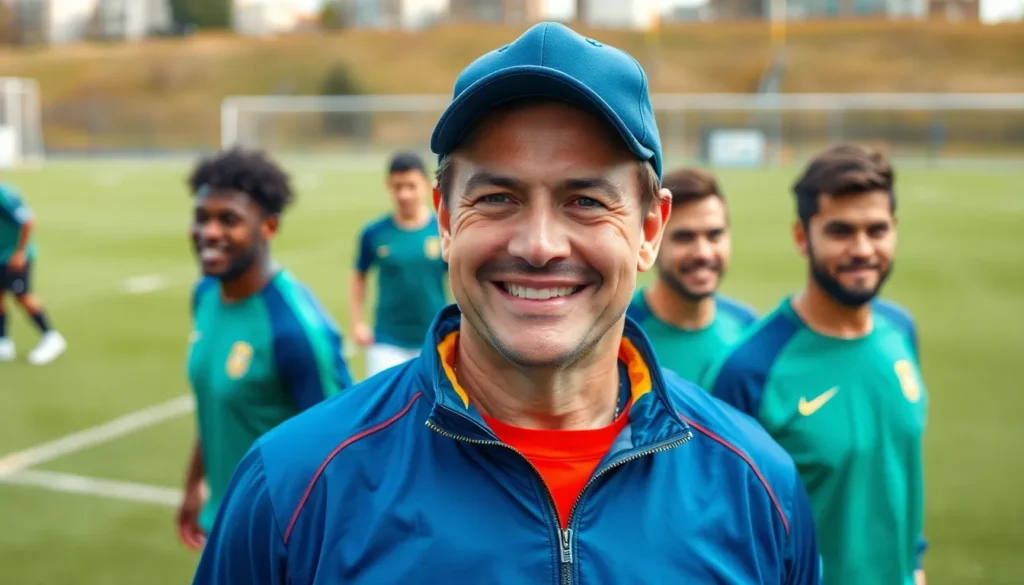Table of Contents
ToggleIn a world where leadership often feels like a high-stakes game of dodgeball, Ted Lasso steps in like a warm hug and a cup of tea. This lovable American football coach turned soccer manager isn’t just about scoring goals; he’s about building a team spirit that even the grumpiest player can’t resist. With his quirky charm and endless optimism, Ted serves up leadership lessons that are as refreshing as a cold pint on a sunny day.
From embracing vulnerability to knowing when to offer a well-timed biscuit, Ted’s approach to leadership is both hilarious and profoundly insightful. Whether you’re in a boardroom or a locker room, these twelve lessons will inspire you to lead with heart, humor, and a sprinkle of Lasso magic. So grab your notepad and get ready to take notes—this isn’t just another playbook; it’s a masterclass in leadership that even the toughest critics can’t ignore.
Overview of Ted Lasso’s Leadership Style
Ted Lasso’s leadership style stands out in its combination of humor, compassion, and authenticity. He creates a positive atmosphere where team members feel valued and understood. Optimism plays a vital role in his approach, encouraging players to embrace challenges and learn from setbacks.
Embracing vulnerability defines Ted’s technique. He models openness, allowing others to feel comfortable communicating their feelings. This transparency fosters trust and strengthens team dynamics. Moreover, Lasso recognizes the importance of emotional intelligence, addressing players’ emotional needs alongside their professional development.
Collaboration takes center stage in Ted’s methods. He empowers team members to contribute ideas and expertise without fear of judgment. This inclusive environment leads to innovation and growth within the team. When providing feedback, Ted does it constructively, focusing on support rather than criticism.
Adaptability is another key trait in Ted’s leadership. He adjusts strategies and expectations based on the team’s evolving dynamics and circumstances. Such flexibility demonstrates resilience and encourages team members to remain open-minded and agile.
By prioritizing relationships, Ted builds strong connections with players. He understands that investing time in personal interactions enhances overall team performance. Encouragement becomes a cornerstone of his philosophy, celebrating small victories and fostering a sense of shared achievement.
Ultimately, Ted Lasso embodies a leadership style that blends warmth with effectiveness. His approach provides valuable insights for leaders across various sectors, showcasing the power of leading with heart and humor.
Lesson 1: Believe in Yourself

Believing in oneself serves as the foundation of effective leadership. Ted Lasso exemplifies how self-confidence influences team dynamics and fosters collective success.
The Power of Positivity
Positivity cultivates an environment where players thrive. Optimistic attitudes help team members tackle challenges head-on, transforming setbacks into opportunities for growth. Ted encourages his players to maintain this attitude. Focusing on strengths leads to increased performance and boosts morale, establishing a culture of resilience. Inspiration flows from Ted’s unwavering belief in his team’s potential, motivating players to surpass their limits. Celebrating even minor accomplishments reinforces this positive mindset, which amplifies their confidence and creates unity.
Overcoming Doubts
Ted Lasso confronts self-doubt by embracing vulnerability. Acknowledging fears empowers team members to address personal insecurities and seek support. Ted shares his own struggles, fostering trust within the team. Open conversations about weaknesses allow individuals to transform doubts into motivation. Emphasizing growth over perfection leads to a stronger, more cohesive team. When players witness their leader built on self-belief, they find encouragement to confront challenges, enhancing their resilience and commitment to the team’s goals.
Lesson 2: Build a Strong Culture
Building a strong culture remains essential to Ted Lasso’s leadership approach. He cultivates an environment where everyone feels valued and empowered.
Creating a Supportive Environment
Supportive environments enable team members to take risks without fearing failure. Ted demonstrates this by encouraging players to express their thoughts openly. He listens actively, which builds trust and solidifies relationships. When all voices are heard, individuals feel more confident in their contributions. Laughter and positivity foster connections among teammates, making it easier to navigate challenges together. By prioritizing mental wellness, Ted ensures that players prioritize each other’s emotional health and well-being. A supportive culture ultimately enhances individual performance and strengthens team cohesion.
Fostering Team Collaboration
Collaboration thrives under Ted’s leadership style. Encouraging open dialogue sparks creativity and innovation among players. They share ideas in brainstorming sessions without the worry of judgment. Diverse perspectives lead to more robust solutions, reflecting the team’s overall growth. Ted promotes shared accountability and celebrates collective achievements. When teammates support one another, they develop a strong sense of belonging. Shared goals unify the group, making each win feel like a team victory. This collaborative spirit drives the team toward excellence, demonstrating how important teamwork remains in achieving success.
Lesson 3: Empathy in Leadership
Empathy stands as a cornerstone of effective leadership in Ted Lasso’s approach. Understanding team members’ needs enables leaders to connect on a deeper level, fostering a supportive environment.
Understanding Team Members’ Needs
Recognizing individual motivations fuels team dynamics. Ted actively listens to his players, ensuring they feel heard and valued. He observes verbal and non-verbal cues, adapting his communication style to meet their unique needs. Addressing personal challenges contributes to a culture of inclusivity, allowing players to express themselves openly. Prioritizing team members’ well-being creates a safe space for growth, turning adversity into opportunity. This attention to emotional intelligence promotes resilience, strengthening the bond between Ted and his team.
Building Trust Through Vulnerability
Exhibiting vulnerability cultivates trust within the team. Ted shares his own experiences, illustrating that it’s okay to be imperfect. This openness encourages players to express insecurities without fear. Building trust leads to increased collaboration, as team members feel secure in sharing ideas. Employees take greater risks when they know their leader values authenticity. Emphasizing transparency reinforces relationships, enhancing overall team performance. Ted’s willingness to show vulnerability exemplifies the power of empathy in leadership, promoting a healthier work environment.
Lesson 4: The Importance of Communication
Effective communication forms the backbone of Ted Lasso’s leadership style. Prioritizing open dialogue fosters strong relationships and enhances team dynamics.
Active Listening Techniques
Active listening plays a crucial role in Ted’s approach. He engages fully with team members, reflecting back what they say to show understanding. Asking clarifying questions ensures he grasps their concerns precisely. Each interaction involves non-verbal cues, such as eye contact and nodding, demonstrating his genuine interest. Additionally, Ted cultivates an environment where players feel heard, encouraging them to express their thoughts openly. By practicing patience and empathy in conversations, he enhances trust within the team. These techniques create a supportive atmosphere where collaboration thrives.
Clarity in Messaging
Clarity in messaging enhances Ted’s effectiveness as a leader. He communicates expectations straightforwardly, ensuring everyone understands their roles. Using simple language keeps his messages accessible for all team members. Repeating key points reinforces important concepts, minimizing confusion. Ted illustrates ideas through relatable examples, making abstract strategies tangible. Emphasizing positivity in communications encourages a vibrant team atmosphere. Moreover, providing regular feedback helps players understand their progress and areas for improvement. This clarity not only directs effort but also strengthens team cohesion, aligning everyone towards shared goals.
Lesson 5: Embrace Vulnerability
Embracing vulnerability plays a crucial role in effective leadership. Ted Lasso exemplifies this as he opens up to his team about his own challenges and insecurities. Sharing personal struggles creates a safe space for team members to express their feelings. This openness builds trust, allowing players to feel comfortable discussing their issues. By showing vulnerability, Ted humanizes himself, deepening connections with his team and strengthening overall morale.
Leading by Example
Leading by example is a key component of Ted’s approach. Displaying his own vulnerabilities, he encourages his team to do the same. When Ted admits mistakes or shares fears, players feel empowered to confront their challenges. Such transparent leadership fosters an environment of authenticity where every individual feels valued. Trust grows stronger as team members recognize that it’s okay to be imperfect and seek support from one another.
The Strength in Openness
Openness is a strength that enhances Ted’s leadership style. Encouraging dialogue, he invites players to share their thoughts and feelings regularly. When team members express uncertainties or fears, it fosters a culture of collaboration. Openness paves the way for creative solutions to emerge, transforming potential setbacks into opportunities for growth. Ted’s approach illustrates that embracing vulnerability not only drives personal development but also cultivates a resilient team dynamic capable of facing obstacles together.
Lesson 6: Adaptability and Flexibility
Ted Lasso demonstrates that adaptability and flexibility are crucial in effective leadership. He approaches challenges with a mindset focused on solutions, adjusting strategies as necessary. When players encounter unforeseen issues, Ted encourages them to think creatively and re-evaluate their tactics.
Responding to Challenges
Responding to challenges involves more than just immediate action. Ted models a calm demeanor during crisis moments, which instills confidence in his team. Flexibility becomes evident when he adjusts his coaching techniques based on real-time feedback. Not only does he address the specific needs of his players, but he also fosters an environment where change is embraced. Trust grows as Ted reassures his team that adaptability is a pathway to success.
Learning from Setbacks
Learning from setbacks is integral to Ted’s leadership style. He emphasizes that mistakes provide valuable lessons, turning failures into opportunities for growth. By analyzing what went wrong, his team gains insights that drive improvement. Encouraging reflection on experiences aids in enhancing performance and resilience. Each setback is treated not as a defeat but as a stepping stone, reinforcing a culture of continuous learning and development.
Ted Lasso’s leadership lessons resonate far beyond the soccer field. His unique blend of humor, empathy, and adaptability creates a framework for effective leadership that anyone can adopt. By prioritizing trust and open communication, he cultivates a culture where team members feel valued and empowered.
Each lesson encourages leaders to embrace vulnerability and foster collaboration, ultimately driving team success. Ted’s approach serves as a reminder that effective leadership isn’t just about achieving goals, but also about nurturing relationships and creating a supportive environment. These insights can inspire leaders to approach their roles with heart and humor, transforming their teams and organizations.





